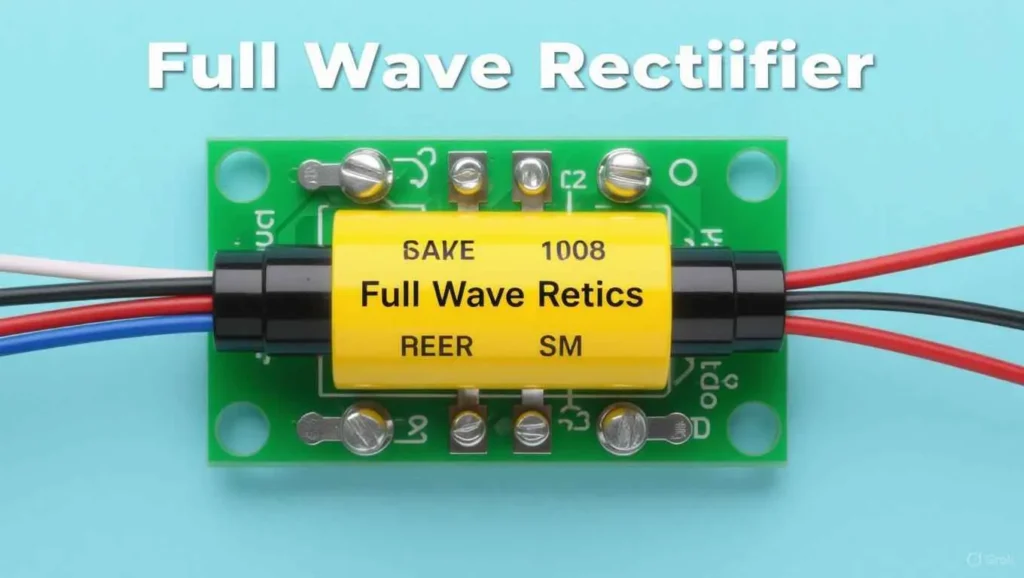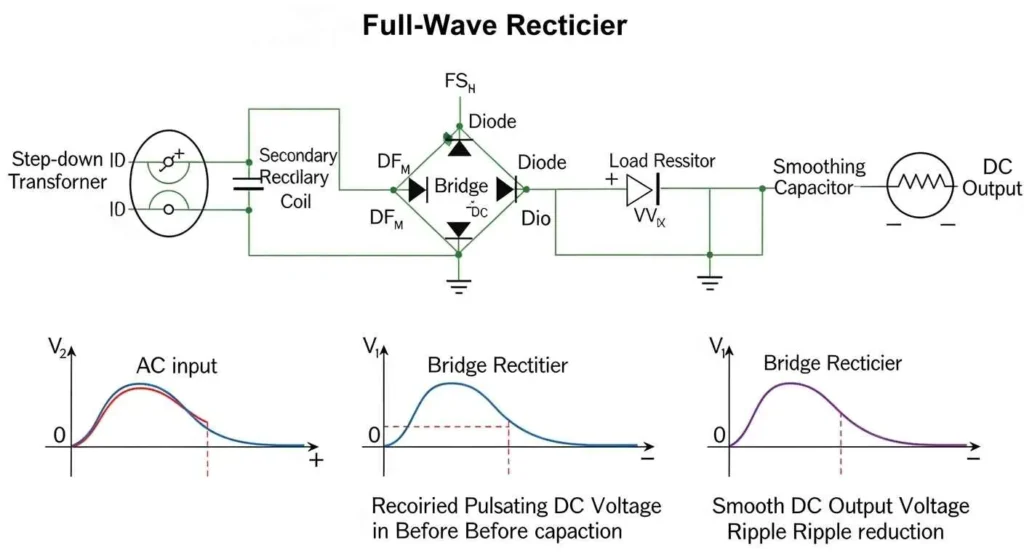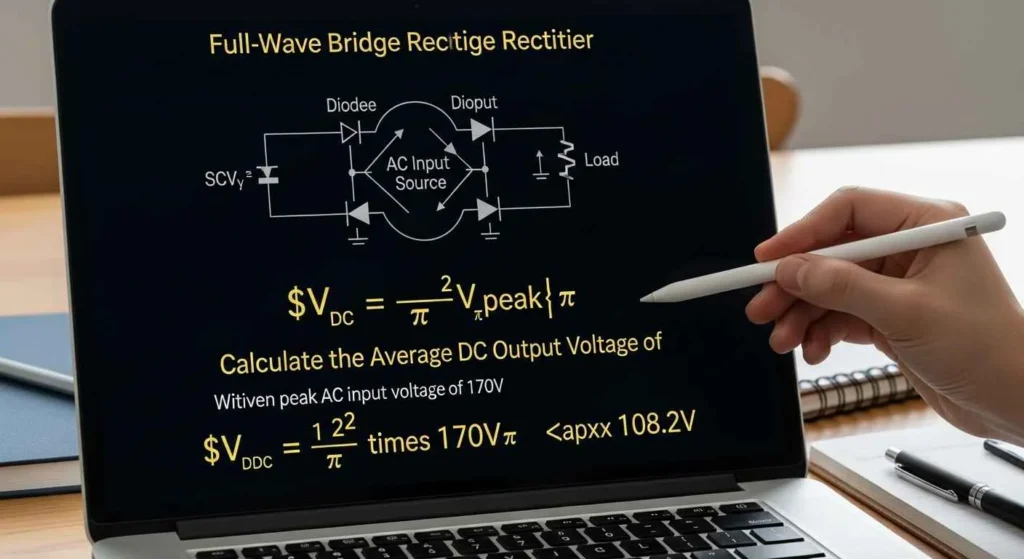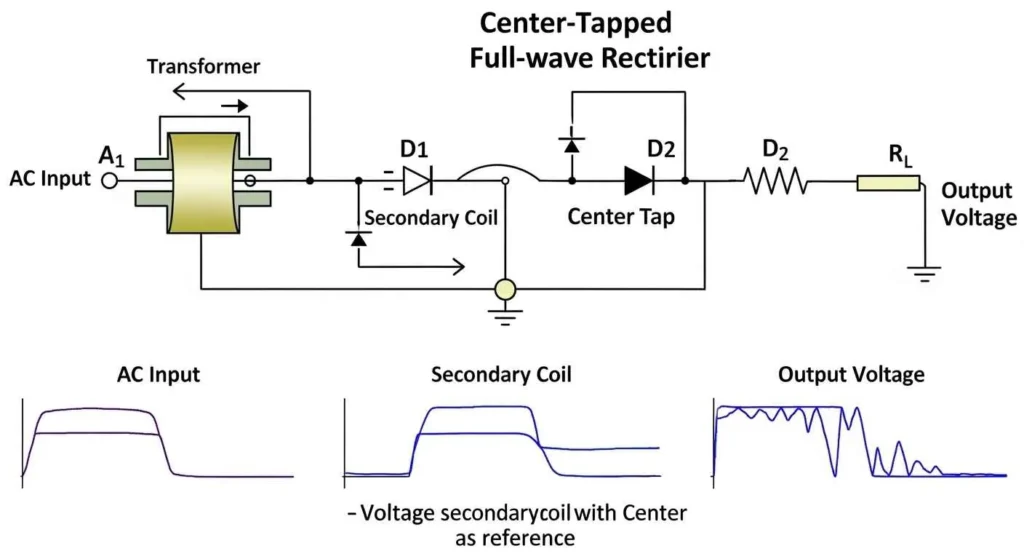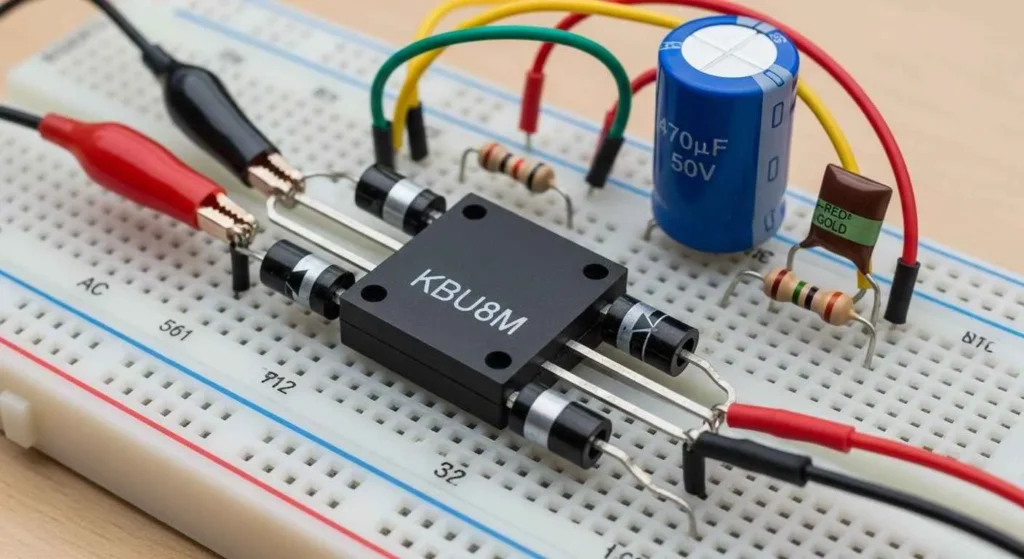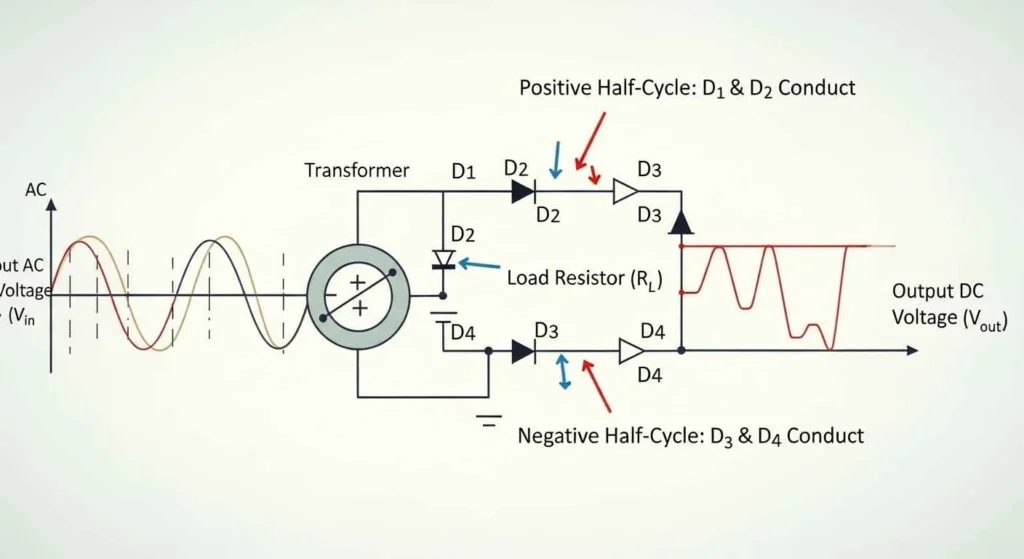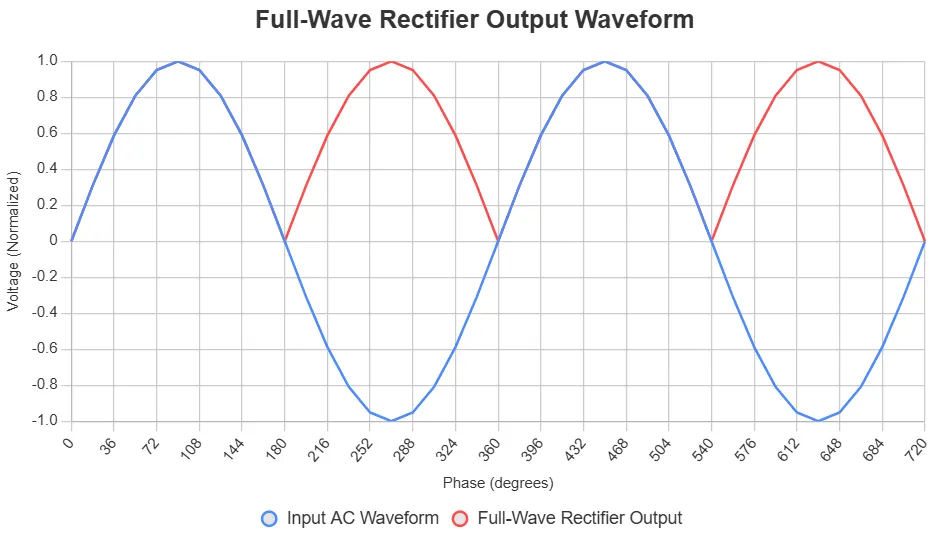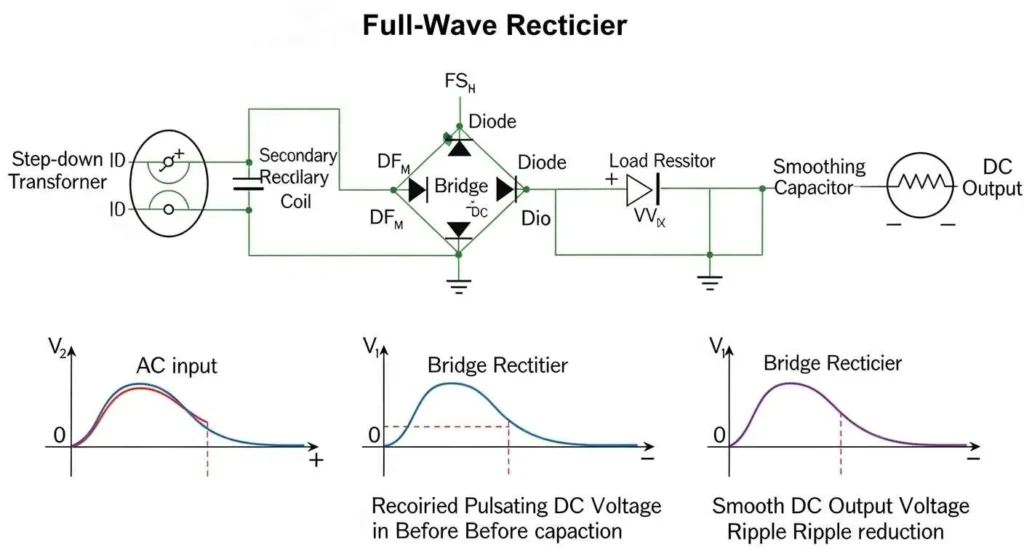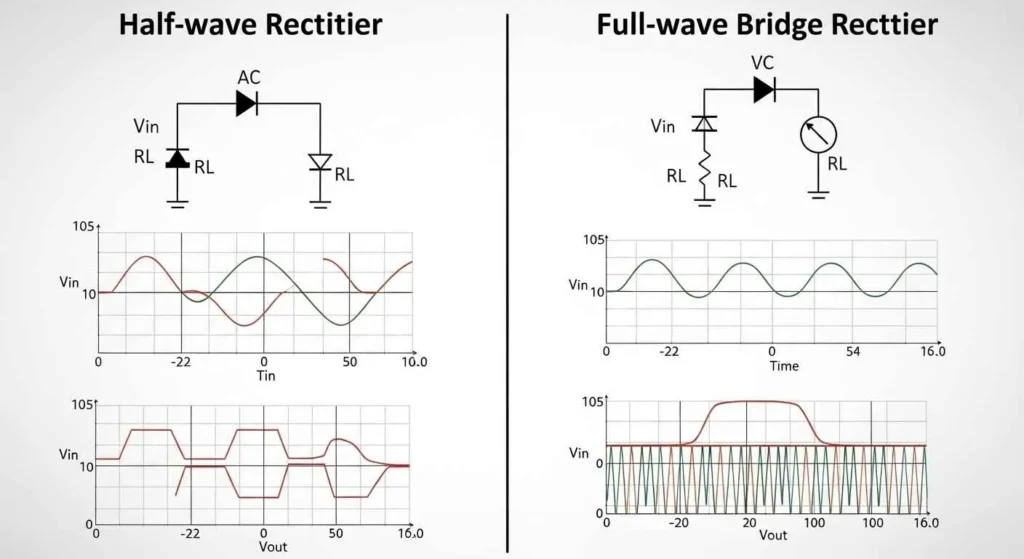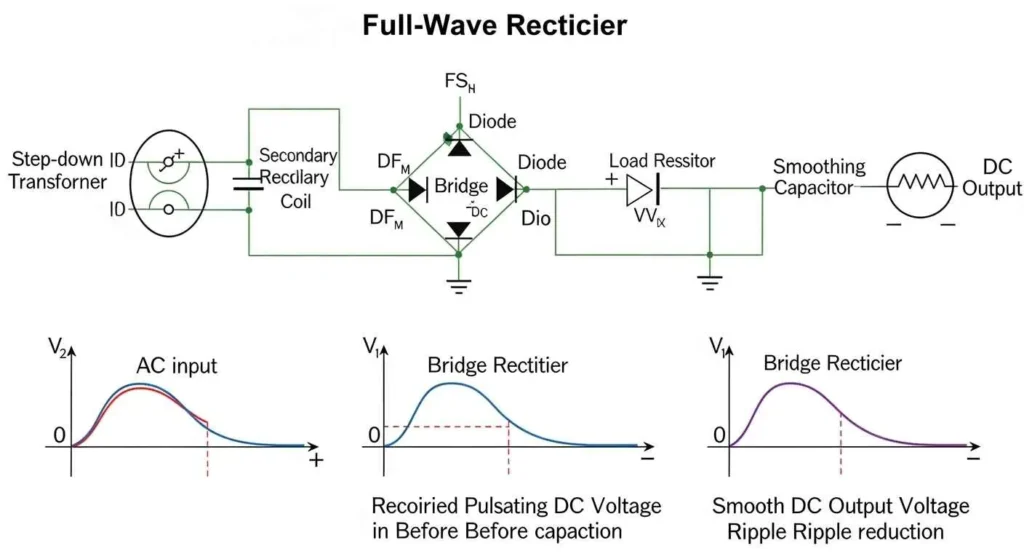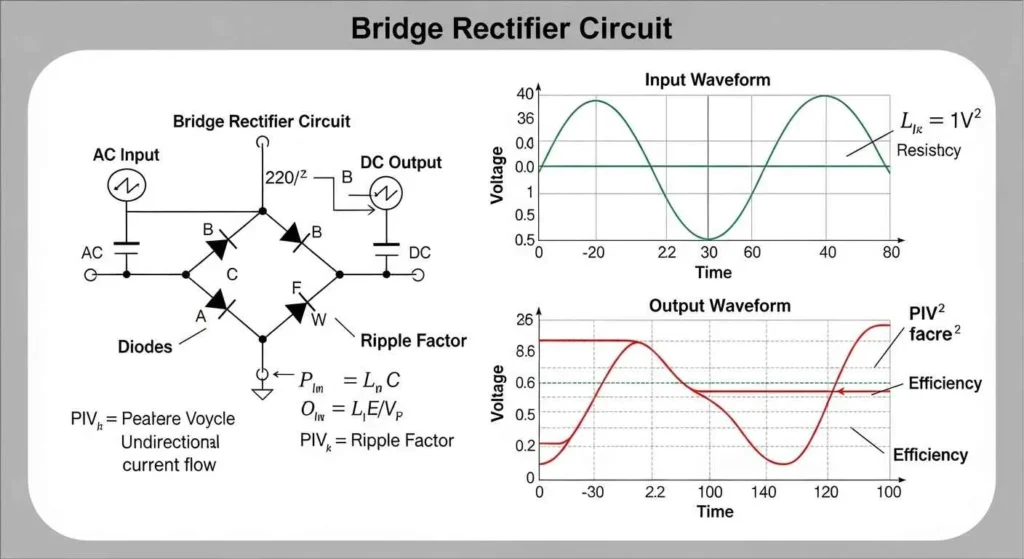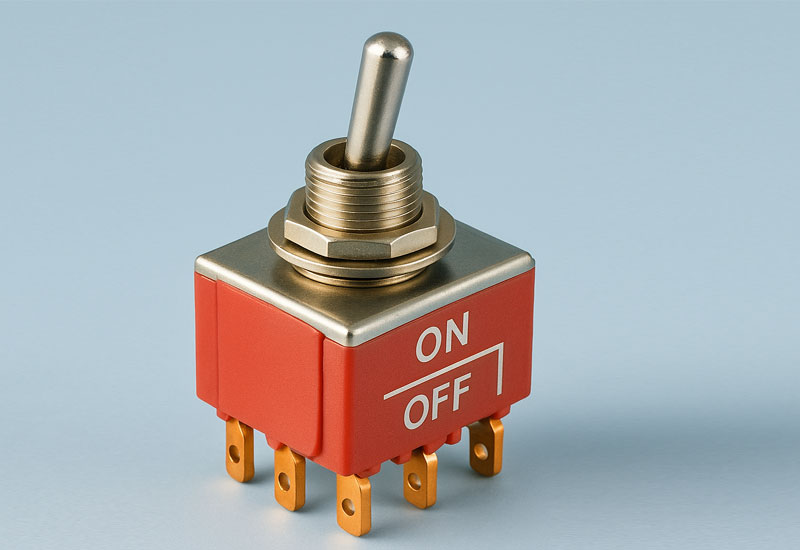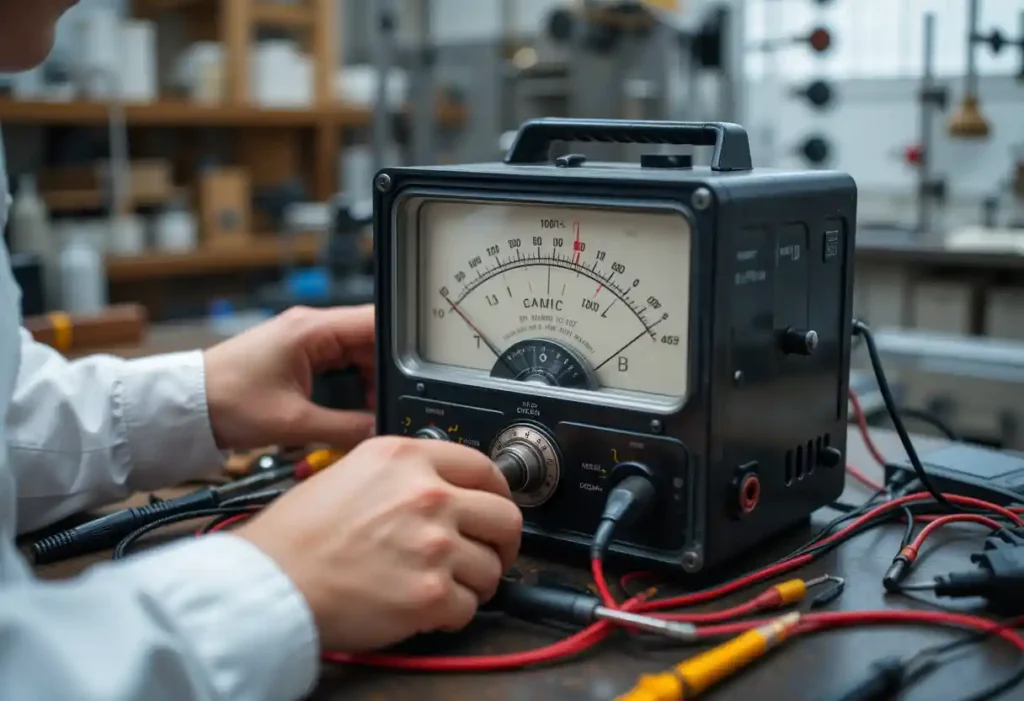Introduction to Full Wave Rectifiers
In the world of electronics, converting alternating current to direct current is a fundamental process that powers countless devices, from simple chargers to complex systems. A full wave rectifier stands out as a key component in this conversion, efficiently utilizing both halves of the AC waveform to produce a smoother DC output. This guide dives deep into the full wave rectifier, explaining its principles, circuits, and real-world uses in a way that’s accessible yet detailed. Whether you’re a student exploring AC to DC conversion or an engineer seeking insights on rectifier efficiency and ripple factor, you’ll find comprehensive explanations here, including practical calculations and comparisons with half wave rectifiers. By understanding the full wave rectifier circuit, including types like the center tapped full wave rectifier and bridge rectifier, you’ll grasp how it enhances voltage regulation in DC power supplies. This article goes beyond basics, offering actionable advice on building and testing these circuits, ensuring you can apply the knowledge directly. Discover why full wave rectifiers are essential in modern electronics, outperforming simpler alternatives in efficiency and output quality.
What is a Full Wave Rectifier?

A full wave rectifier is an electronic circuit designed to convert the entire AC input signal into a pulsating DC output, making it a vital AC to DC converter. Unlike simpler designs, it processes both the positive and negative halves of the AC cycle, resulting in a more consistent DC power source. This capability makes it ideal for applications requiring stable direct current power supply, such as in power DC supply systems where voltage regulation is crucial.
The core function involves diodes that direct current flow, ensuring the output remains unidirectional. In contexts like DC voltage converter setups, this rectifier type integrates well with components like zener diodes for enhanced voltage regulation. For instance, when paired with a DC power supply module, it supports efficient energy transfer, minimizing waste.
Experts often highlight its role in switch mode power supply designs, where it handles AC 12V inputs effectively. The rectifier’s ability to produce DC powered outputs positions it as a cornerstone in electronics, surpassing basic half bridge configurations in performance.
Full Wave Rectifier Definition

Defining a full wave rectifier involves recognizing it as a device that rectifies both halves of an AC waveform into DC, providing a higher average output voltage. This full wave rectifier definition underscores its superiority in AC to DC voltage converter applications, where consistent DC supply power is needed.
In detailed circuit property explanations, the full wave rectifier stands out for its use of diode bridges or center taps, enabling seamless conversion. When integrated with a silicon controlled rectifier for controlled rectification, it enhances precision in power management.
Such definitions often link to foundational concepts, emphasizing how it serves as a reliable DC power source in various setups.
Types of Full Wave Rectifiers
Full wave rectifiers come in primary configurations, each suited to specific needs in electronics. The center tapped full wave rectifier uses a transformer with a center tap, employing two diodes to handle each half cycle, ideal for balanced loads.
Alternatively, the bridge rectifier, also known as diode bridge rectifier, utilizes four diodes in a bridge formation, eliminating the need for a center tap and offering robustness in high-power scenarios.
Both types excel in converting AC to DC, with the diode bridge often preferred for its simplicity in DC to DC voltage converter integrations.
Center Tapped Full Wave Rectifier

The center tapped full wave rectifier employs a transformer with a center-tapped secondary winding and two diodes. During the positive half cycle, one diode conducts while the other blocks, directing current through the load. In the negative half cycle, the roles reverse, ensuring continuous DC flow.
This configuration provides insights on diode configurations, making it suitable for applications requiring stable voltage, such as in buck converter systems where voltage regulation follows rectification.
Practical implementations often include schottky diodes for lower forward voltage drops, enhancing efficiency in DC power setups.
Bridge Rectifier

A bridge rectifier consists of four diodes arranged in a closed loop, converting AC to DC without a center-tapped transformer. It allows current to flow through the load in the same direction during both half cycles, producing a pulsating DC output.
This design serves as a comprehensive rectifier type resource, commonly used in power supply for testing environments due to its reliability.
Incorporating elements like photo diodes in sensing applications alongside the bridge can expand functionality, though primarily it’s for core rectification.
How Does a Full Wave Rectifier Work?

The operation of a full wave rectifier begins with an AC input applied to the diodes. In a bridge setup, two diodes conduct during the positive half, routing current to the load, while the other two handle the negative half, maintaining unidirectional flow.
This process minimizes ripple, aiding in electronics and circuit behavior analysis. For smoother outputs, capacitors are added, filtering the DC power. In systems involving half bridge topologies, the full wave approach offers better performance, especially when combined with DC voltage converter modules.
Full Wave Rectifier Circuit
Constructing a full wave rectifier circuit involves connecting diodes strategically to handle AC phases. For a bridge version, diodes form a diamond shape, with AC input at opposite points and DC output at the others. This circuit excels in circuit-related electronics applications, often incorporating zener diodes for voltage clamping.
Full Wave Rectifier Output Waveform

The output waveform of a full wave rectifier appears as a series of positive humps, representing the rectified AC halves. Without filtering, it pulsates at twice the input frequency, showing less ripple than half wave outputs.
This waveform is key for practical calculation guides, allowing engineers to compute averages and RMS values. In DC powered devices, smoothing capacitors transform this into near-constant voltage, essential for stable operation.
Advantages of Full Wave Rectifier
Full wave rectifiers offer higher efficiency, reaching up to 81.2 percent, by utilizing both AC halves. This leads to lower ripple factors, around 0.48, providing smoother DC outputs. They integrate well with switch mode power supply units, enhancing overall system performance. Advantages include better voltage regulation when paired with zener diodes, making them preferable for direct current power supply needs.
Disadvantages of Full Wave Rectifier
Despite benefits, full wave rectifiers require more diodes, increasing complexity and cost. The peak inverse voltage is higher, demanding robust components. In some setups, like those with silicon controlled rectifiers, additional controls add layers. Disadvantages also include potential heat generation in high-power applications, necessitating cooling.
Full Wave Rectifier Formula and Calculations

Calculations for full wave rectifiers involve key formulas for performance metrics. The average DC voltage is (2 * V_peak) / π, where V_peak is the maximum input voltage. For RMS output, it’s V_peak / √2. These formulas aid in rectifier efficiency assessments, crucial for design.
Rectifier Efficiency
Rectifier efficiency measures how effectively AC power converts to DC, calculated as (DC power output / AC power input) * 100. For full wave, it’s approximately 81.2 percent, double that of half wave. This efficiency supports foundational rectifier concepts, especially in buck converter integrations where minimal loss is key.
Ripple Factor
The ripple factor quantifies AC remnants in DC output, given by √((V_rms / V_dc)^2 – 1), yielding 0.48 for full wave rectifiers. Lower values indicate smoother outputs. This metric is vital for electronics and circuit behavior, influencing filter designs in DC supply power systems. Practical tips include using larger capacitors to reduce ripple in power DC supply modules.
Peak Inverse Voltage
Peak inverse voltage represents the maximum reverse voltage diodes withstand, equaling 2 * V_peak in center tapped designs. Proper selection prevents breakdown.
Calculations for PIV guide component choices in full wave rectifier examples, ensuring reliability in real-world scientific applications.
In diode bridge setups, PIV is V_peak, offering advantages in certain configurations.
Half Wave vs Full Wave Rectifier

Comparing half wave and full wave rectifiers reveals stark differences. Half wave uses one diode, rectifying only half the cycle, with efficiency at 40.6 percent and ripple factor of 1.21. Full wave employs multiple diodes, achieving 81.2 percent efficiency and 0.48 ripple factor, providing twice the output frequency. Full wave excels in applications needing stable DC power, like voltage regulation in AC to DC converters.
Applications of Full Wave Rectifier
Full wave rectifiers find extensive use in DC power supplies, converting AC mains to DC for electronics. They enable voltage regulation with zener diodes, stabilizing outputs in direct current power supply units. In battery chargers, they provide efficient charging via DC power supply modules. Audio systems benefit from their low ripple, ensuring clean signals.
They power motors in industrial settings, integrating with buck converters for stepped-down voltages. In testing labs, they serve as power supplies for testing, handling AC 12V inputs. Medical devices rely on them for reliable DC powered operations, often using schottky diodes for efficiency.
Communication equipment uses them for demodulation, while voltage multipliers employ them for high DC outputs. In renewable energy, they convert inverter outputs, pairing with silicon controlled rectifiers for control.
Full Wave Rectifier in DC Power Supply

In DC power supplies, full wave rectifiers form the core, transforming AC to pulsating DC, then smoothed for use. They support voltage regulation, often with zener diodes or regulators.
This setup creates stable DC power sources, essential for electronics requiring consistent power DC supply. Bridge rectifiers are common here, offering compact designs for DC supply power needs.
Voltage Regulation with Full Wave Rectifier
Voltage regulation post-rectification maintains steady DC despite load changes. Zener diodes clamp voltages, while regulators like linear or switch mode ensure precision. In full wave setups, this integration provides reliable outputs for sensitive devices, enhancing overall system trustworthiness.
Building a Full Wave Rectifier: Step-by-Step Guide
To build a full wave rectifier, start by selecting components: four diodes for a bridge, a transformer, and a load resistor. Connect diodes in bridge formation, attaching AC input to two junctions and DC output to the others.
- Add a capacitor across the output for smoothing. Test with a multimeter, observing the waveform on an oscilloscope.
- This hands-on approach demonstrates practical knowledge from electronics experiments, useful for power conversion projects.
- Safety tips include using appropriate ratings to avoid shocks, and incorporating fuses.
Simple Experiment to Observe Full Wave Rectification
Conduct an experiment by assembling a bridge rectifier on a breadboard with 1N4007 diodes and a 12V AC source. Measure output voltage, noting the pulsating DC.
- Add a 1000μF capacitor, observing reduced ripple. This illustrates real-world applications like power supplies.
- Compare with half wave by removing two diodes, highlighting differences in output quality.
Advanced Topics in Full Wave Rectifiers
Beyond basics, advanced designs incorporate silicon controlled rectifiers for phase control, enabling variable outputs. Harmonic analysis reveals impacts on power quality, mitigated by filters.
In switch mode power supplies, full wave rectifiers pair with PWM for efficient conversion. Schottky diodes reduce losses in high-frequency applications. Photo diodes occasionally integrate in optoelectronic setups, though niche.
Rectifier Properties in Electronics

Rectifier properties include forward voltage drop, reverse recovery time, and thermal characteristics. In full wave designs, these influence efficiency and reliability. For circuit design, selecting diodes with low drop, like schottky, optimizes performance in DC to DC voltage converters. Understanding these properties ensures robust full wave rectifier integration.
FAQ Section
What is the efficiency of a full wave rectifier?
The efficiency reaches 81.2 percent, calculated as the ratio of DC output power to AC input power, making it suitable for applications needing minimal energy loss.
What is the difference between half wave and full wave rectifier?
Half wave rectifies only one AC half, with 40.6 percent efficiency and higher ripple, while full wave uses both halves for better efficiency and smoother output.
What is the ripple factor in full wave rectifier?
It’s 0.48, indicating lower AC remnants compared to half wave’s 1.21, leading to more stable DC.
How does a full wave rectifier improve over half wave?
By utilizing the full AC cycle, it doubles output frequency and halves ripple, enhancing suitability for DC power supplies.
What are common applications?
They power chargers, audio equipment, and industrial motors, providing reliable DC from AC sources.

